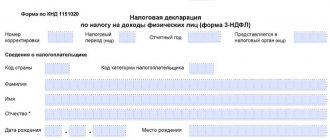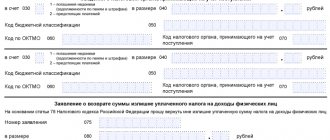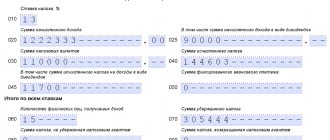What is “VAT deductible”
The total amount of VAT that a taxpayer must pay to the budget can be reduced by tax deductions. In Art. 171 of the Tax Code of the Russian Federation there is a complete and closed list of transactions for which VAT can be deducted. The benefit is valid in the following cases:
- VAT has been paid on goods, works, services, property rights (hereinafter referred to as GRU), which are planned to be resold or used in activities subject to VAT.
- VAT is calculated and paid when importing goods and materials into the Russian Federation or when fulfilling the obligations of a tax agent.
- Construction and installation work was completed for our own needs.
- Contractors submitted VAT when carrying out assembly and disassembly, installation and dismantling, capital construction or liquidation of fixed assets.
- An advance has been received or issued for future payment.
- After the sale, the price or quantity of goods shipped, work performed, services provided, or property rights changed.
- The goods were returned to the seller or a buyback was carried out.
- A contribution to the authorized capital was received in the form of property, property rights or intangible assets.
- VAT is paid on travel expenses.
- VAT is compensated using the tax free system.
- A foreign organization has charged VAT for the purchase of electronic services.
Offsetting mutual claims and VAT in 2020-2021 in the absence of termination of the agreement
Currently, the offset of mutual claims under the Civil Code of the Russian Federation, which occurs in terms of existing debts under existing agreements and, in essence, is a form of debt payment, does not entail any consequences in relation to VAT, despite the fact that in the documents formalizing the offset mutual requirements according to the sample, its amount is indicated.
This is due to the fact that the acceptance of VAT for deduction on goods, works, services purchased on the territory of the Russian Federation, starting from 2009, is in no way related to the fact of payment of this tax. Read more about the deduction procedure in the article “What is the procedure for applying (accepting) tax deductions for VAT: conditions” .
Thus, in order to make a deduction for purchases made in the Russian Federation, the simultaneous presence of three circumstances turns out to be important (Articles 171 and 172 of the Tax Code of the Russian Federation):
- the purchase is intended for use in transactions subject to VAT;
- the purchased item has been capitalized;
- there is an invoice issued without errors critical for deducting VAT.
Offsetting mutual claims in such a situation represents the repayment of mutual debts (payment), which are not reflected in the fact of the deduction.
Find out about the tax and accounting consequences of offsetting mutual claims in the Transaction Guide from ConsultantPlus. To do this, get trial access to the K+ system and study the material for free.
Who can apply VAT deductions
Only VAT payers can take advantage of the deduction - that is, organizations and entrepreneurs on OSNO or Unified Agricultural Tax.
The remaining special regimes are exempt from VAT, so tax cannot be deducted on them. Instead, tax amounts are included in the cost of purchased goods or separately included in expenses.
To accept VAT as a deduction, you must comply with all the conditions from Art. 171 Tax Code of the Russian Federation. If this is not done, during an audit the tax office may deprive the right to deduction and charge additional input tax. In general, VAT can be deducted if four conditions are simultaneously met:
- VAT is presented by the supplier;
- purchased GWS will be resold, used in VAT-taxable transactions or exports;
- purchased GWS are accepted for accounting;
- the supplier presented a correctly executed invoice or UPD.
In fact, it is not necessary to pay VAT to the supplier to qualify for the deduction. But there are exceptions, for example, VAT on the cost of imported goods can be deducted only after paying the tax at customs.
Let's consider the conditions in more detail.
Condition 1. VAT is presented by the supplier
In addition to the price of sold GWS, the supplier must submit VAT for payment. The tax amount is reflected in the contract, invoice and primary sales documents.
When the supplier has not highlighted VAT in the documents, it cannot be calculated and deducted independently. This happens, for example, when working with counterparties on the simplified tax system or foreign sellers.
But if the buyer performs the duties of a tax agent, he must independently calculate and pay VAT to the budget.
Keep records of exports and imports in the Kontur.Accounting web service. Simple accounting, payroll and reporting in one service
Condition 2. Purchased GWS will be resold, used in VAT-taxable transactions or in exports
You cannot claim a deduction for goods and services that are used in non-VAT-taxable transactions. In this case, the input tax is included in the cost of the purchased GWS.
The deduction can be used only if input VAT is paid on an object that is involved in taxable transactions or export works and services (excl. Article 149 of the Tax Code of the Russian Federation).
If you initially bought goods for use in non-taxable transactions, but then decided to resell them or use them in taxable activities, VAT can be deducted. Conversely, when purchasing goods for use in taxable transactions and actual use in non-taxable ones, the VAT accepted for deduction must be restored.
If during the reporting quarter you had both taxable and non-taxable VAT transactions, start keeping separate records. Take part of the tax on taxable transactions as a deduction, and include the rest of the input VAT in the cost of purchases.
Condition 3. Purchased goods and materials are accepted for accounting
Purchased goods and materials must be capitalized according to accounting rules, only then can input VAT be deducted. Capitalization must be confirmed by documentation - a correctly executed primary document.
GWS can be considered capitalized, the cost of which is reflected in the accounting accounts. For example, goods for resale should be reflected on account 41, work and services - on accounts 20, 44, etc.
Also fill out the primary registration form for the goods and services accepted for registration. These can be standard documents or independently developed forms: invoices, receipt orders, acts, invoices, etc.
Condition 4. The supplier presented a correctly executed invoice or UPD
You must receive an invoice or a universal transfer document (UDD) from the supplier. If there are no invoices, they are issued with violations or are not reflected in the VAT return, do not accept input tax as a deduction (Article 172 of the Tax Code of the Russian Federation, letter of the Federal Tax Service dated October 21, 2013 No. ММВ-20/3/96).
An invoice or UPD is not always required (clauses 2.1, 3, 6–8 of Article 171 of the Tax Code, letter of the Ministry of Finance dated September 16, 2019 No. 03-07-14/71091). This is not necessary when importing goods, receiving a contribution to the management company, VAT compensation for a foreigner, or purchasing electronic services from foreign companies. In such cases, invoices can be replaced with other documents. For example, for property on account of a contribution to the authorized capital, these could be acts OS-1, OS-1a, etc. To do this, the documents also need to indicate the amount of VAT recovered by the participant.
Additional terms
In order to deduct VAT on some transactions, additional conditions must be met. For example, to deduct VAT, which you must pay yourself, the tax must be transferred to the budget. To deduct VAT on property against a contribution to the management company, the participant must restore the tax to the budget.
Also, for some transactions, special conditions for accepting tax for deduction are established, and all four listed above do not apply. For example, to deduct VAT on an advance payment, the buyer needs an invoice from the seller, an agreement with the condition of the advance and a payment document for its payment. In order for the seller to be able to deduct VAT on the advance received, he must ship the goods or return the advance to the buyer.
Tricky VAT offset
When offsetting mutual claims, the amount of VAT presented by the taxpayer to the buyer of goods (works, services) is paid to him on the basis of a payment order for the transfer of funds (clause 4 of Article 168 of the Tax Code of the Russian Federation). Offsetting is carried out for the amount of debt excluding VAT, and the parties pay the amount of tax to each other through a current account.
The obligation is terminated in whole or in part by offsetting a counterclaim of a similar nature, the term of which has arrived or is not specified or is determined by the moment of demand (Article 410 of the Civil Code of the Russian Federation).
Documentary confirmation
To confirm the mutual settlement made, it is rational to first reconcile the calculations and formalize it with a reconciliation act. This document is not contained in albums of unified forms. Therefore, it can be compiled in any form, but with all the necessary details listed in paragraph 2 of Article 9 of the Federal Law of November 21, 1996 No. 129-FZ “On Accounting”. In this case, it is advisable to reflect the details on the basis of which the debts arose, as well as the amounts of the debts themselves, including VAT.
Next, you need to draw up an act of mutual settlement, which will serve as documentary evidence of the repayment of debt to the counterparty (letter of the Department of Tax Administration for the city of Moscow dated May 13, 2002 No. 24-11/21484).
It should be noted that there is no direct indication of the need to draw up an offset act, since to offset VAT, an application from one party is sufficient. In this case, the obligations are considered terminated by offset not from the moment the act is signed or one of the parties receives the application, but from a later date of fulfillment of the obligation (clause 3 of the information letter of the Presidium of the Supreme Arbitration Court of the Russian Federation dated December 29, 2001 No. 65). All business transactions carried out by the company must be documented with supporting (primary accounting) documents (Clause 1, Article 9 of the Federal Law of November 21, 1996 No. 129-FZ “On Accounting”, Article 313 of the Tax Code of the Russian Federation). This means that an act of offset will still have to be drawn up.
attention
The validity of the deduction during offset is confirmed not only by the presence of an invoice and the fact of receipt of the goods. The justification will also be a payment order for payment of VAT to the counterparty by bank transfer.
Procedure for offset of VAT during offset
When selling goods (works, services), the seller is obliged to present to the buyer for payment, in addition to their price, the corresponding amount of value added tax. In primary payment documents and invoices, the VAT amount must be highlighted as a separate line. This is due to the fact that when making calculations, the taxpayer needs to deduct only the VAT amounts actually paid to suppliers by separate payment order (Clause 2 of Article 172 of the Tax Code of the Russian Federation). The act of offset is drawn up for a monetary amount excluding VAT amounts.
From the set of rules arising from paragraph 2 of Article 172 and paragraph 4 of Article 168 of the Tax Code, it follows that the validity of the deduction during offset must be confirmed not only by the presence of an invoice and the fact of receipt of the goods.
The third condition is the presence of a payment order for the payment of VAT to the counterparty, and exclusively in a non-cash manner (letters of the Ministry of Finance of Russia dated January 18, 2008 No. 03-07-11/18, No. 03-07-15/05, dated May 24, 2007 No. 03-07-11/139). However, the Seventeenth Arbitration Court, in its decision dated April 1, 2008 No. 17AP-1712/2008-AK, indicated that in case of offsets, “input” VAT can be deducted even if the tax amount was not transferred on the basis of a payment order, but in another way.
If payment for purchases is made partly by offset and partly in cash, then the amount of VAT indicated in payment orders is determined by calculation. The basis here will be the share of tax that falls in such situations on non-cash forms of payment (letter of the Ministry of Finance of Russia dated March 7, 2007 No. 03-07-15/31).
Moreover, from January 1, 2008, deductions are made only in the tax period in which the VAT amount is transferred to the supplier. The presence of a payment order to transfer the VAT amount is a prerequisite for deduction (letter of the Ministry of Finance of Russia dated January 18, 2008 No. 03-07-15/05, dated April 28, 2008 No. 03-07-11/168).
Thus, if the amount of VAT was previously accepted for deduction (at the time of acceptance for accounting), then, when making an offset, it must be restored in the tax period when the deduction was declared, that is, on the date of capitalization. However, if goods (work, services) were accepted for accounting before January 1, 2007, then when offset, the VAT amounts declared for deduction at the time the goods (work, services) were accepted for accounting do not need to be restored (letter from the Ministry of Finance of Russia dated January 18 2008 No. 03-07-15/05).
Example
In the first quarter of 2008, the Buyer purchased goods in the amount of 118,000 rubles, including VAT of 18,000 rubles, capitalized them and set them to deduct VAT in full. However, in the second quarter of 2008, a Settlement Certificate in the amount of 100,000 rubles was signed between the Buyer and the Seller, and the counterparties transferred the VAT amounts to each other in separate payment documents. Moreover, the transfers themselves were made only in the third quarter of 2008.
In the second quarter, the Seller made the necessary corrections to the purchase book for the first quarter of 2008, drawing up an additional sheet in it and removing the Seller’s invoice from it. I also had to submit an updated VAT return for the first quarter of 2008 and pay penalties for “underpayment” of tax to the budget. In the “new” purchase book, this invoice was registered only in the third quarter of 2008 (on the date of transfer of the VAT amount to the counterparty).
Accordingly, the amount of VAT is recorded in the VAT return in the third quarter of 2008 on line 220 in the total amount of deductions with its breakdown on line 240.
The buyer's accounting will reflect the following transactions:
In the first quarter of 2008:
Debit 41 Credit 60 - 100,000 rub. — the goods have been capitalized;
Debit 19 Credit 60 - 18,000 rub. — VAT on the purchased goods is taken into account;
Debit 68 Credit 19 - 18,000 rub. — VAT on the purchased goods has been credited.
In the second quarter of 2008:
Debit 60 Credit 62 - 100,000 rub. — the offset of mutual claims is reflected;
Debit 68 Credit 19 - RED REVERSE - 18,000 rubles. — previously credited VAT on the purchased goods has been reversed.
In the third quarter of 2008:
Debit 60 Credit 51 - 18,000 rub. — VAT is transferred to the supplier;
Debit 68 Credit 19 - 18,000 rub. — VAT on the purchased goods and paid by offset is credited.
Please note: The Tax Code does not regulate the timing of the exchange of payments during netting, however, in letter dated May 24, 2007 No. 03-07-11/139, the Ministry of Finance of Russia indicated that the transfer must be made in the tax period when the netting is carried out.
What to do if one of the parties is not a VAT payer? The answer can be found in the letter of the Ministry of Finance of Russia dated April 28, 2008 No. 03-07-11/168. According to it, the provisions of Chapter 21 of the Tax Code have not established exceptions for buyers who are exempt from fulfilling the duties of a VAT taxpayer and are not recognized as taxpayers of this tax.
Therefore, such a buyer of goods (works, services) should still pay the appropriate amount of tax by a separate payment order. Moreover, when making non-monetary forms of payment for goods (work, services) sold, the specified buyer must also apply the above rule of paragraph 4 of Article 168 of the Tax Code. These clarifications were given in letters of the Ministry of Finance of Russia dated May 18, 2007 No. 03-07-14/14, dated March 7, 2007 No. 03-07-15/30, dated May 24, 2007 No. 03-07-11 /139.
it is important
If the VAT amount was previously accepted for deduction, then at the time of offset it must be restored to the date of receipt of goods (work, services).
The counterparty did not transfer the VAT amount
In practice, situations may arise when one of the counterparties did not transfer the VAT amount to the other during offset or the tax rates differ from each other. The question immediately arises: what to do with the “stuck” amounts?
Since during offset the Seller will not transfer the amount of VAT back to the Buyer, the Buyer will have this amount of VAT taken into account in the debit of account 62 “Settlements with buyers and customers”. This is due to the fact that in relation to the Seller, the Buyer is also the Seller.
The resulting receivables can be:
- repaid by the counterparty by transferring funds to the current account;
- written off after the expiration of the limitation period;
- forgiven to the counterparty.
In accounting, such transactions are reflected by transferring funds to the current account - posting: Debit 51 Credit 62.
When writing off accounts receivable after the expiration of the limitation period (in accordance with the Civil Code, three years, which cannot be changed by agreement of the parties), these amounts in accounting are written off as other expenses (debit of account 91). This is done on the basis of inventory records, written justification or order from the head of the organization.
It should be noted that within five years from the date of write-off, the organization must account for the written-off debt in off-balance sheet account 007 “Debt of insolvent debtors written off at a loss.”
In tax accounting, amounts of bad receivables are written off as non-operating expenses (subclause 2, clause 2, article 265 of the Tax Code of the Russian Federation). In addition, the taxpayer has the right to take into account the full amount of receivables in expenses, including VAT (decision of the Constitutional Court of the Russian Federation dated May 12, 2005 No. 167-O, letter of the Ministry of Finance of Russia dated October 7, 2004 No. 03-03-01-04/1 /68, letter of the Federal Tax Service of Russia for the city of Moscow dated June 5, 2007 No. 20-12/052920).
If the debt is forgiven, then this operation can be expressed as an expression of the will of both parties or the will of only the creditor. At the same time, in order to avoid misunderstandings, whether it is an agreement, a contract or a notice of debt forgiveness, it is necessary to clearly indicate which debt is being forgiven and what its amount is. It is also necessary to indicate the details of the documents on the basis of which it arose.
In accounting, debt forgiveness is equated to a gratuitous transfer and is recognized as other expenses, which are reflected in the debit of account 91 “Other income and expenses” (D-t 91/2 K-t 62).
When determining the tax base for income tax, the amount of forgiven debt does not reduce it. This position is based on paragraph 16 of Article 270 of the Tax Code, which states that the cost of gratuitously transferred property (work, services, property rights) is not taken into account in expenses. At the same time, VAT is not charged on the amount of forgiven debt associated with previously shipped goods (work, services), since in case of gratuitous transfer the tax base is determined on the day of shipment (clause 6 of Article 167 of the Tax Code of the Russian Federation).
Consequently, the creditor (seller) has already charged VAT on the date of shipment of goods (work, services), and by the time the debt to the buyer is forgiven, he does not have additional obligations to charge VAT.
T. Kovalenko, auditor
Stay up to date with the latest changes in accounting and taxation! Subscribe to Our news in Yandex Zen!
Subscribe
When can you claim a VAT deduction?
The deduction can be submitted in the quarter in which all mandatory conditions are met. Example. Algorithm LLC purchased goods for resale and capitalized them on July 1 (3rd quarter). At the same time, the supplier issued an invoice with the allocated amount of VAT on June 30 (2nd quarter). Algorithm LLC fulfilled the last condition (accepted goods for accounting) only in the 3rd quarter, so the organization can declare a deduction no earlier than in the declaration for the 3rd quarter.
If an organization had received goods on June 30 and received an invoice on July 24, it could have taken advantage of the deduction in the 2nd quarter. There is an important condition here: the invoice must be received before the 25th of the month following the quarter, that is, before the deadline for filing the declaration.
VAT deductions for past periods can be claimed within three years from the date of capitalization. When returning an advance payment or goods, the deduction can be claimed within a year; the three-year period does not apply in this case.
VAT refund procedure.
Let's talk about the VAT refund procedure. When submitting a declaration to the tax service, the taxpayer must indicate the amount to be reimbursed, and the tax office reviews this declaration and carries out a (desk) audit, the purpose of which is to justify the amounts declared in the declaration. If, as a result of such an audit, no violations are revealed, then the tax service must make a decision on refunding the tax amount within 7 days. If there are violations, then the tax office must draw up an audit report, which, with the documents attached to it, goes to the head of the tax service for consideration and making a decision: or not to hold the taxpayer accountable for a tax offense. Also at the same moment, a decision must be made on a partial or full refund of the tax amount, or a refusal to refund.
If the taxpayer is in debt for other federal taxes, then the tax service has the right to offset the amount of tax that is subject to reimbursement against the debt on fines or penalties, etc.
Calculation of VAT for deduction
To calculate VAT deductible, add up all VAT on your transactions listed in Art. 171 Tax Code of the Russian Federation. However, remember that all conditions must be met to claim a deduction; check this before including the tax on the transaction in the calculation.
Keep records of exports and imports in the Kontur.Accounting web service. Simple accounting, payroll and reporting in one service
The tax office checks all VAT claimed for deduction for compliance with the conditions, and another criterion is its amount. Inspectors have their own standards for deductions. If yours turns out to be larger, tax officials may require clarification or come with an audit.
There is no exact data on how the Federal Tax Service considers the “Safe Deduction”. Typically one of two methods is used:
- Method 1. The Federal Tax Service calculates the share according to declarations for the year and compares it with the threshold value of 89 percent.
- Method 2. The Federal Tax Service calculates the share according to the declarations for the quarter and compares it with the average share of deductions by region.
Calculate your share of deductions using the formula:
Share of deductions = All deductions (p. 190 section 3) / Accrued VAT (p. 118 section 3) × 100%
If the percentage of deductions is greater than the safe amount, you can carry them forward to later quarters or claim them in installments over three years. Both transfer and division into parts are valid only for deductions from clause 2 of Art. 171 Tax Code of the Russian Federation.
How to reflect the VAT deduction in the declaration
The amounts of VAT to be deducted are reflected in lines 120-190 of section 3 of the VAT return. In lines 120-185, the deduction is distributed by type. And in line 190 the total amount of deduction for the quarter is calculated; for this, the values from lines 120-185 are added together.
Next, from line 118, which indicates the amount of tax including recovery, subtract line 190. This way you will receive the amount of VAT payable or refundable. If the difference between lines 118 and 190 is greater than 0, reflect the VAT payable in line 200, if less, reflect the VAT payable in line 210.
Credit and refund of VAT at the tax office.
Everyone knows that VAT refunds can occur in the following ways:
— VAT offset: an operation related to the repayment of the taxpayer’s debt to pay penalties, arrears, etc.;
— VAT refund to the Federal Treasury: the tax service sends documents on the basis of which the refund operation is carried out.
There is a significant difference between the concepts of offset (return) and compensation.
The offset or refund of VAT at the tax office concerns VAT that was unlawfully paid to the budget.
VAT refund refers to VAT legally paid to the budget or to the supplier.
The difference that is received if the amount of the tax deduction is greater than the total amount of tax is subject to reimbursement (offset, refund based on the results of the tax period).
Postings for registering VAT deductions
| Wiring | Operation |
| Dt 19 Kt 60 | Input VAT on goods, works, services, property rights is reflected |
| Dt 68 Kt 19 | Input VAT is accepted for deduction |
| Dt 76 Kt 68 | VAT has been charged on advance payments towards future deliveries |
| Dt 68 Kt 76 | Accepted for deduction of VAT on an advance received previously from a buyer or an advance paid to a supplier |
| Dt 19 Kt 68 | VAT accepted for deduction has been restored |
| Dt 91-2 Kt | Recovered VAT is written off as expenses |
Keep VAT records in the Kontur.Accounting web service. The service will indicate which documents need to be completed and which transactions need to be monitored in order to avoid fines and reduce VAT payable. The system makes it easy to keep records, payroll and report via the Internet. The first two weeks in Accounting are free for all new students.




